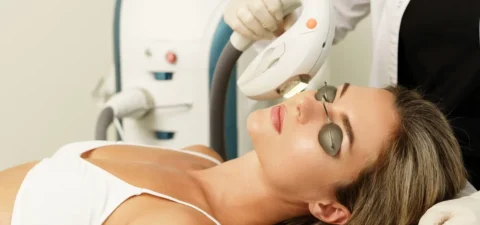For information only. Not meant as advice in any form. Please consult your medical professional or lawyer.
Patients want the best professionals to take care of their skin and help address their cosmetic issues. This is why a lot of individuals are going to medical spas and dermatology clinics to consult with skincare specialists. However, there’s one career that can provide more than just expert skin care advice but also perform advanced procedures for facial rejuvenation—medical estheticians.
So what exactly does a medical aesthetician do? Medical estheticians or aestheticians are professionals trained to administer noninvasive cosmetic procedures to treat a wide range of skin problems. They can provide services in different work environments such as med spas, dermatology clinics, and healthcare facilities. Compared to regular estheticians, a medical aesthetician has additional training in advanced skin care treatments and techniques.
What Can Medical Estheticians Do? 6 Common Responsibilities
Not anyone can be entrusted to perform cosmetic treatments in a clinical or medical setting. In most states, you need to be specially trained and licensed to provide advanced facials and skincare procedures. One of the professionals who work closely with patients in any med spa or dermatology practice is a medical esthetician.
Medical estheticians are highly skilled and trained individuals who can provide medical-level skin treatments. They can work with physicians and doctors to help diagnose and treat different complex cosmetic conditions, such as acne scars, pigmentation issues, and other issues such as skin trauma or burns.
Some people might think that an esthetician is a medical assistant, but they’re responsible for more advanced tasks that help run a medical spa. They may also be called a paramedical esthetician in other work environments. Here are the other common roles of a medical esthetician in any practice:
1) Patient Screening and Diagnosis
Medical aestheticians are usually the first people that patients see prior to their cosmetic procedure. They can assist doctors in examining a client’s condition and gather necessary information regarding their medical history and create charts. Additionally, they’re the ones who are responsible for coordinating proper care and treatment and making sure that it’s aligned with the patient’s specific concerns and goals.
2) Skin Consultation and Analysis
A medical esthetician is also familiar with advanced anatomy, physiology, and histology of the skin to accurately diagnose a patient’s cosmetic concerns. This allows them to perform thorough examinations and create individualized treatment plans that will address the main cause of the skin condition. Upon initial consultation, they can recommend the best solutions that will improve a patient’s damaged or aging skin.
3) Pre- and Post-Operative Care
Medical estheticians are also responsible for preparing the client before a specific skin care treatment. Although they mostly administer nonsurgical procedures, they still have to prepare the treatment area to avoid possible infections and complications during the session. They can also advise clients on how to take care of their skin after the treatment to guarantee a smooth recovery so they can achieve their desired results.
4) Administering Skin Care Treatments
One of the main roles of a medical esthetician is to perform facial services and cosmetic procedures. Depending on the skin problem, a medical aesthetician may suggest microdermabrasion, facial massages, scrubs, and chemical peel treatments. They may also provide makeup applications, eyebrow shaping, threading, and lip plumping. Some states may also allow medical estheticians to perform injectables such as Botox and dermal fillers.
5) Using Energy-Based Devices for Advanced Cosmetic Applications
A medical aesthetician can also receive training in performing energy-based procedures, such as intense pulsed light therapy, radiofrequency skin tightening, and laser treatments. They can provide laser hair removal, tattoo removal, birthmark correction, varicose vein removal, and cellulite reduction.
6) Recommending Skincare Products to Clients
As skin care specialists, medical estheticians can also suggest the best products that can help maintain a client’s skin health and appearance. They can help upgrade a patient’s beauty routine by recommending products that suit their skin type. They can also share their knowledge on how to properly apply and use these products to ensure patients can get the maximum benefits.
Where Do Medical Estheticians Work?
Unlike standard esthetician jobs, a medical esthetician career can give you more opportunities to work in various environments. With medical-level skills and knowledge, you can take your employment further to other locations such as:
- Plastic surgery clinics
- Dermatology offices
- Specialty burn clinics
- Medical spas
- Healthcare facilities
- Oncology clinics
- Rehabilitation centers
- Hospitals
- Private medical practices
What Is A Medical Esthetician License?
Being licensed as a medical aesthetician certifies that you can provide services in any clinic or medical setting. Anyone who’s a licensed esthetician can apply for additional hands-on training and education to become a medical esthetician. The requirements for licensure typically vary per state so you should always check with your state board if you wish to pursue a medical esthetician career.
How Do You Become A Licensed Medical Aesthetician?
If you already have an esthetician license and wish to further your career, you can get additional training from a dedicated medical esthetician school, cosmetology college, or vocational university. Here’s an overview of what it takes to obtain your medical esthetician accreditation:
- Finish a specialized medical esthetician training program: There are many aesthetician schools today that offer medical esthetics courses for aspiring paramedical estheticians. Typically, these programs include 600 to 1000 hours of theoretical learning and hands-on training sessions.
- Get your state medical esthetician license: After completing the training course, you can obtain your license by applying to your province’s cosmetology board. In most cases, you’ll need to present proof that you’ve completed the required number of training hours to qualify for licensure. You may also be required to showcase your competency by passing a state exam.
- Pursue continuing education: Once you have your medical esthetician license, you may establish your expertise by getting additional training and certifications for specific treatments, such as laser procedures, electrolysis, and cosmetic injections.
What Is The Difference Between a Medical Esthetician and Esthetician?
There’s a fine line between regular estheticians and medical estheticians. Although they both require attending cosmetology schools, they can differ in terms of the scope of their responsibilities, training hours, and work environments. Here’s a table showing the distinctions between a medical and non-medical esthetician:
| Medical Esthetician | Standard Esthetician | |
| Number of training hours required | May require an additional 600 to 1000 hours of specialized medical esthetician training | May need 260 to 1000 hours of esthetician training |
| Common responsibilities | They can work with doctors to coordinate medical care, create medical charts, conduct consultations, and assist physicians with medical treatment | A standard license allows estheticians to assist with patients consultations, coordinate treatments, suggest skincare products, and perform administrative tasks as needed |
| Services they can provide | Skin resurfacing and body treatments with lasers, microdermabrasion, dermaplaning, advanced chemical peels, laser tattoo removal, acne treatments | Basic facial services, chemical peels, waxing, makeup application, eyelash extension |
| Where they can work | Medical spas, healthcare facilities, and other specialty clinics | Day spas, beauty salons, wellness centers, dermatology clinics |
What Makes The Best Medical Esthetician: Important Skills You Need to Have
To be able to provide quality care and efficient treatments, you also need to know the skills that are necessary for the medical esthetician job. Here are some of the best qualities and traits to have to succeed in the medical esthetics field:
- Excellent time management and planning skills
- Knowledge of the ingredients in skin care products and how they interact with each other
- Interpersonal and communication skills
- Marketing and selling skills
- Good organization skills for administrative responsibilities
- Great attention to detail
- Ability to follow safety protocols and maintain the sanitation of treatment rooms
Improve Your Aesthetic Skill With Online Training Courses From FACE Med Store
A medical esthetician can work closely with different patients in various settings to provide medical-grade treatments to improve their skin health and appearance. If you want to advance your career in medical aesthetics, you need to receive specialized training to become a licensed medical esthetician.
You can also supplement your aesthetic skills with advanced online courses from FACE Med Store. We offer a wide selection of educational modules and programs on facial aesthetics and cosmetic injectables that can help you succeed as a medical esthetician. For more information on our training courses or other products, call us today.






